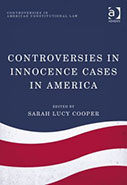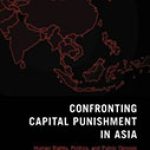Controversies in Innocence Cases in America

Editor: Sarah Lucy Cooper
Publisher: Farnham, Surrey, UK; Burlington, VT: Ashgate Publishing, 2014. 246p.
Reviewer: Daniel S. Medwed | November 2014
The effort to investigate and litigate claims of innocence by prisoners has experienced growing pains in the twenty-five years since post-conviction DNA testing first exonerated an American inmate. But now it is fair to say that these collective efforts have reached an age of maturity; they represent a true political, legal and social “movement.” Controversies in Innocence Cases in America, a collection of essays edited by Sarah Lucy Cooper, evaluates the impact of this movement. It is a nice addition to the scholarly literature, with offerings from some of the finest academics in the field.
A major challenge with any edited collection, of course, is to group and sequence the chapters in a way that makes sense. Cooper manages to do this skillfully, starting off with two terrific pieces in Part I that explore “The Rise of the Innocence Movement in America.” Keith Findley leads off by declaring quite convincingly that the Innocence Movement “has been the most dramatic development in the criminal justice world since the Warren Court’s Due Process Revolution of the 1960s” (3). Findley not only catalogues the history of the innocence movement with great care but also evaluates its effect on the Supreme Court, on paradigms for viewing criminal justice, and on policy initiatives. Among other topics, Findley’s essay contains a thoughtful discussion of how evidence of wrongful convictions has altered the death penalty debate. Jacqueline McMurtrie then builds on Findley’s contribution by homing in on a specific feature of the innocence movement: its organizational and governance structure. She analyzes the birth and evolution of the Innocence Network to link together a motley crew of independent innocence groups to pool resources, facilitate the sharing of ideas, consolidate political clout at the national level, and pursue a host of other endeavors. McMurtrie astutely identifies the challenges posed by the prospect of “a network, where members were only loosely affiliated and quite different from one another” (24), and takes a look at how the Network has risen (or occasionally not risen) to those challenges.
Next, in Part II, Cooper presents four essays that address the fundamental question of “How Are Innocent People Convicted? Common Causes of Wrongful Convictions.” To be fair, several large forests have already been sacrificed in the name of articles on the causes of wrongful convictions. Nevertheless, for the most part these four chapters manage to add fresh insights to the discussion. Jules Epstein presents a clear primer on issues concerning eyewitness misidentification, which is the leading cause of wrongful conviction in the United States, and Lissa Griffin provides a helpful summary of the rules and reform efforts related to the withholding of exculpatory evidence by prosecutors. Carrie Leonetti’s interesting contribution to Part II addresses something that has received little attention in scholarly circles so far—American aid for “Rule of Law” programs overseas. Leonetti makes the compelling, data-driven case that such “assistance is aimed almost exclusively at helping foreign legal institutions investigate and prosecute crimes” (88) and that the “asymmetry” in comparison to support for foreign defense work enhances the risk of wrongful convictions. To buttress her argument, Leonetti explores how poor performance by defense counsel in adversary systems can lead to the conviction of the innocent. In Leonetti’s view, civil law nations are increasingly adopting components of the adversary system, making the need for a vigorous and adequately-funded defense bar worldwide all the more important.
Also in Part II, a trio of scholars—Deborah Davis, Richard Leo, and Michael Williams—explore a fascinating aspect of false confessions. The common wisdom is that suspects who falsely confess during police interrogations to crimes they did not commit typically do so either because of individual vulnerability (such as youth or cognitive infirmity), the coerciveness of the interrogation tactics themselves, or some combination of those two factors. But false confessions do occasionally surface when those factors are absent; Leo et al. train their elite scholarly eyes on this issue and ask the poignant question of whether “false confessions occur in response to milder interrogations, and in more normal suspects, than commonly assumed” (57). Most notably, they explore “the base rate at which false confessions occur (i.e., the percentage of all interrogation-induced confessions that are false)” (60) and reach the reasonable conclusion that pinpointing a single base rate is impossible. Still, the authors float several ideas as to why false confessions probably occur with greater frequency than generally believed and then creatively evaluate the impact of this assertion on courtroom proceedings.
Part III shifts gears to the question of process—how does one investigate, prove or define innocence in a way that promotes justice. In an excellent chapter, Leslie and Michael Risinger differentiate the role of an “innocence lawyer” from that of the traditional criminal defense lawyer, aptly observing that the approach to “signaling” lies at the core of the distinction. The defense lawyer must embrace “a strong ‘anti-signaling’ ethic’” (124) by neglecting to allude to either the guilt or innocence of a client. Yet an innocence lawyer’s role “inherently involves signaling of a well-warranted belief in actual innocence” (125). This distinction, in turn, begets different professional responsibilities; the innocence lawyer usually must engage in an extensive preliminary investigation of a case before even agreeing to represent a defendant. Part of this preliminary investigation may include requiring potential clients to be as forthcoming as possible, and even waive their attorney-client privilege with respect to previous communications with other lawyers.
Following the Risingers’ piece, Carrie Sperling offers a nice analysis of how most state post-conviction procedures make it difficult to reopen a criminal case, let alone overturn it, largely due to the systemic reliance on the “finality” of verdicts. Blending theoretical insights and practical tips, Sperling argues that the emphasis on finality is “antiquated” (140) in light of what we have learned about wrongful convictions. Ultimately, she makes a compelling case for why “[f]inality should give way to accuracy” (154). The last Chapter in Part III, by Francine Banner, looks at how “constructions of innocence” that privilege DNA and scientific evidence to overturn wrongful convictions have meaningful consequences for the legions of cases that lack such firm indicia of innocence. In Banner’s eyes, “[a]s we embrace the positive impact of the DNA revolution on otherwise forgotten persons, it is important to be mindful, also, that the constitution retains the capacity to provide recourse for others who have been overlooked (172).”
Part IV of the book naturally migrates to the topic of reform. Given the rise of the Innocence Movement, the detection of the causes of wrongful convictions, and the identification of hurdles to the correction of these errors, how can we tweak the system to promote justice? Nancy Marion and Marvin Zalman analyze the political dynamics of three major innocence reform efforts in recent years and “explore the Innocence Movement and innocence projects as interest groups, assessing how closely innocence projects align with theories of policy making” (176). They conclude that these examples of reform efforts reflect “a mixed picture of effectiveness” (186), and evaluated these results through a series of intriguing theories of policy making that derive from political and social science research. Lastly, Cooper herself pens a Chapter on American “Innocence Commissions,” entities that vary in structure and mission but that Cooper ably sorts into three categories: error correction, systemic reform, and integrity units. I found her attempt to define, classify, and examine the hodge-podge of innocence commissions very beneficial.
Overall, Controversies in Innocence Cases in America does what any good edited collection should do—and more. It adds to the scholarly conversation in the field; contains chapters that differ with but still speak to one another; and is organized in a sensible manner.
Daniel S. Medwed is Professor of Law at Northeastern University School of Law and recipient of the 2013 Robert D. Klein University Lectureship.


